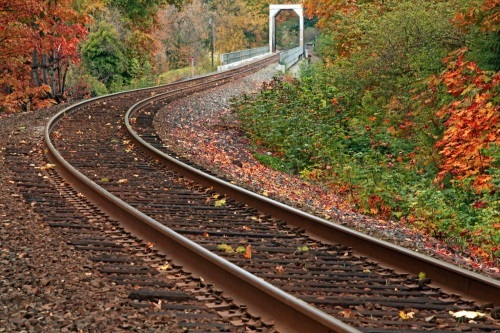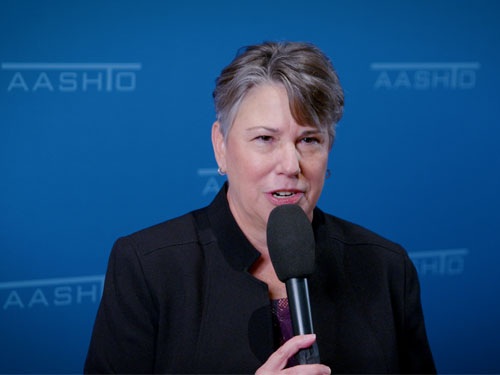The Federal Railroad Administration has awarded $8.2 billion in grants to 10 passenger rail projects nationwide – funding that also supports rail corridor planning activities in 44 states as well.
[Above image by Libreshot]
According to a statement, the FRA said that $8.2 billion is flowing through two distinct discretionary grant programs created by the Infrastructure Investment and Jobs Act or IIJA: the Federal State Partnership for Intercity Passenger Rail program and the Corridor Identification and Development or Corridor ID program.

The 10 projects being funded through the Federal State Partnership for Intercity Passenger Rail program will support an existing high-speed rail line California’s Central Valley and help construct a brand-new high-speed rail corridor between Las Vegas and southern California, while also supporting improvements to existing rail corridors along the East Coast and Midwest, as well as in Maine, Montana, and Alaska.
The Nevada Department of Transportation is overseeing the construction of that new Las Vegas-to-California high-speed rail initiative; receiving up to $3 billion in grants to fund the Brightline West High-Speed Intercity Passenger Rail System Project.
The federal grant for that proposed project – which has a total price tag of $10.4 billion – involves right-of-way acquisition, final design, and construction activities for the high-speed rail tracks, four stations and facilities, signal system, rolling stock, roadway modifications, and other associated infrastructure for a new 218-mile intercity passenger rail system between Las Vegas and Rancho Cucamonga in southern California. That project also allows for connections to the Los Angeles Metro area via the Metrolink commuter rail system, FRA said.
Meanwhile, the North Carolina Department of Transportation is receiving up to a $1.1 billion grant from FRA to support the multi-phased effort to develop a new passenger rail route between Raleigh, N.C., and Richmond, VA, along the CSX Transportation “S-Line” as part of the Southeast Corridor that will connect North Carolina with Virginia, Washington, D.C., and the Northeast Corridor.
The Pennsylvania Department of Transportation is getting up to $143 million in grants for the right-of-way acquisition and final design and construction activities for various track and signal-related improvements along Norfolk Southern Railway’s main line between Pittsburgh and Harrisburg, PA. That project will improve system and service performance of freight trains and the Amtrak Pennsylvanian service with additional capacity and other upgrades, allowing for a second daily round trip of Amtrak’s service.
At the same time, FRA is providing grants to 69 corridor planning projects across 44 states via its Corridor ID program; planning initiatives designed to drive future expansion of U.S. passenger rail networks. State departments of transportation receiving grants from this planning program include:
- The Wisconsin Department of Transportation gets $1.5 million to study new rail connects between Milwaukee, WI, and Minneapolis, MN, through Madison and Eau Claire, WI. Separately, the agency will study initiating new daily round trip between Chicago, IL, and St. Paul, MN, to complement the existing Amtrak long-distance Empire Builder – with an extension to Minneapolis, MN. It will also research a new corridor connecting the existing Hiawatha service between Chicago, IL, and Milwaukee, WI, with an extension to Green Bay, WI.
- The Nevada DOT gets $500,000 for its aforementioned work helping build out the Brightline West High-Speed Intercity Passenger Rail System Project linking Las Vegas with southern California.
- The Washington State Department of Transportation gets $1 million for its Cascadia High-Speed Ground Transportation project; a corridor that would connect Vancouver, Canada to Portland, OR, via Seattle, WA, with a potential future extension south to Eugene, OR. That funding also cover a Amtrak Cascades Corridor project that would improve existing state-supported Amtrak Cascades between Vancouver in British Columbia, Canada, and Eugene, OR; a line that includes Seattle, WA, Portland, OR, and other intermediate points.
- The North Carolina Department of Transportation gets $3 million in grants to study a new high-speed rail alignment between Charlotte, NC, and Atlanta, GA, with potential intermediate stops including Greenville-Spartanburg International Airport in South Carolina and Augusta and Athens, GA, then serving a downtown Atlanta station and terminating at Atlanta’s Hartsfield-Jackson International Airport; a proposed corridor that would connect Salisbury, NC, to Asheville, NC, that last hosted passenger trains in 1975; and for a corridor connecting Kings Mountain to Charlotte, NC. The agency also gets a grant to research new service connecting Fayetteville with Raleigh, NC, with intermediate stops at Lillington and Fuquay-Varina, NC, and for new service connecting Raleigh to Wilmington, NC. It will also study new connections between Winston-Salem and Raleigh, with intermediate stops at Greensboro, Burlington, Durham, and Cary, complementing the existing state-supported Piedmont and Carolinian services.
- The Georgia Department of Transportation gets $500,000 for a proposed corridor would connect Atlanta and Savannah, GA. That corridor would provide new service on existing or new alignment, with potential intermediate stops including Athens, Augusta, and Macon, GA.
- The Louisiana Department of Transportation and Development gets $500,000 for a proposed corridor would connect Baton Rouge and New Orleans, LA; providing new intercity passenger rail service on an existing alignment that last hosted passenger trains in 1969.
- The Massachusetts Department of Transportation gets $500,000 for a corridor that would connect Boston, MA, and Albany, NY, via Springfield, MA; providing up to eight daily round-trip passenger trains on an existing alignment that is currently being used by Amtrak’s long-distance Lake Shore Limited.
- The California Department of Transportation gets $2.5 million for a proposed corridor would provide new service over a route currently only served by Amtrak’s long-distance Coast Starlight between San Jose and San Luis Obispo, CA, as well as for new service between Los Angeles and Coachella, CA, using existing alignments currently served by Amtrak’s long-distance Southwest Chief. It will also study a corridor that would enhance the existing state-supported Capitol Corridor between San Jose and Auburn, CA, with an extension to San Francisco, Salinas, and Novato, CA, and to Reno/Sparks, NV. It will also study improvements to the existing state-supported San Joaquin line between Sacramento/Oakland and Merced, CA, with an extension north from Sacramento to Chico and Redding, CA. It will also look at enhancing the existing Pacific Surfliner between San Luis Obispo to San Diego, with an extension south to San Ysidro, CA.
- The Illinois Department of Transportation gets $500,000 for the Chicago to Quad Cities Service Extension Program; a corridor that would connect Chicago to Moline, IL, through Naperville and Wyanet, IL.
- The Texas Department of Transportation gets $1 million to study a new rail connection between Houston and San Antonio, with a new conventional intercity passenger rail service using the route of Amtrak’s existing long-distance Sunset Limited service. It will also study a corridor connecting Fort Worth, Dallas, and Houston with a new conventional intercity passenger rail service over an existing alignment that Amtrak discontinued service on between Dallas and Houston in 1995.
- The Florida Department of Transportation gets $1 million to study the addition and enhancement of rail service connecting the cities of Jacksonville, Orlando, and Miami, as well as a rail corridor linking Miami, Orlando, and Tampa.
- The Minnesota Department of Transportation gets $500,000 to research a new corridor linking Minneapolis to Duluth, MN, through Cambridge and Hinckley, MN.
- The Arizona Department of Transportation gets $500,000 to study a corridor reconnecting Phoenix (Buckeye) to Tucson with multiple daily frequencies. The proposed corridor would reinstate service on an existing rail alignment over which Amtrak discontinued service in 1997.
- The Pennsylvania Department of Transportation $500,000 to research a corridor connecting Scranton, PA, and New York City, with intermediate stops at Stroudsburg and Mt. Pocono, PA and Blairstown, Dover, Montclair, Morristown, and Newark, NJ. The proposed corridor would provide three new daily round trips on a mostly existing alignment, while rebuilding abandoned track to accommodate that new service.
- The New York State Department of Transportation gets $500,000 to study improvements to the existing Amtrak Adirondack service between New York City and Montreal, Quebec, Canada, via Albany, NY, by completing a U.S. Customs Preclearance facility in Montreal and adding a second daily round trip on that line.
- The Michigan Department of Transportation gets $500,000 to study a corridor connecting the existing Wolverine service between Chicago, IL, and Detroit/Pontiac, MI, with an extension to Windsor in Ontario, Canada.
- The Vermont Agency of Transportation gets $1 million to study improvements to the existing Amtrak Vermonter service between Washington, DC, and St. Albans, VT, via Philadelphia, New York City, Hartford, CT, Springfield, MA, and other intermediate points. It will also look into a new corridor connecting New York City, with Burlington, VT, via Albany, NY, and Rutland, VT, dovetailing with the existing Amtrak Ethan Allen Express.
- The Missouri Department of Transportation gets $1 million to study a corridor connecting St. Joseph and Kansas City, MO, which would include a connection with the existing state-supported Missouri River Runner route to St. Louis, MO. It will also research a corridor connecting Hannibal, MO, to Chicago by extending the existing the Illinois Zephyr/Carl Sandburg line between Chicago and Quincy, IL.
- The Kansas Department of Transportation gets $500,000 to study a corridor connecting the existing Heartland Flyer intercity passenger rail service between Fort Worth, TX, and Oklahoma City, OK, with an extension north to Wichita and then Newton, KS.
 Top Stories
Top Stories
USDOT Makes $1.5B Worth of BUILD Grants Available
December 19, 2025 Top Stories
Top Stories

